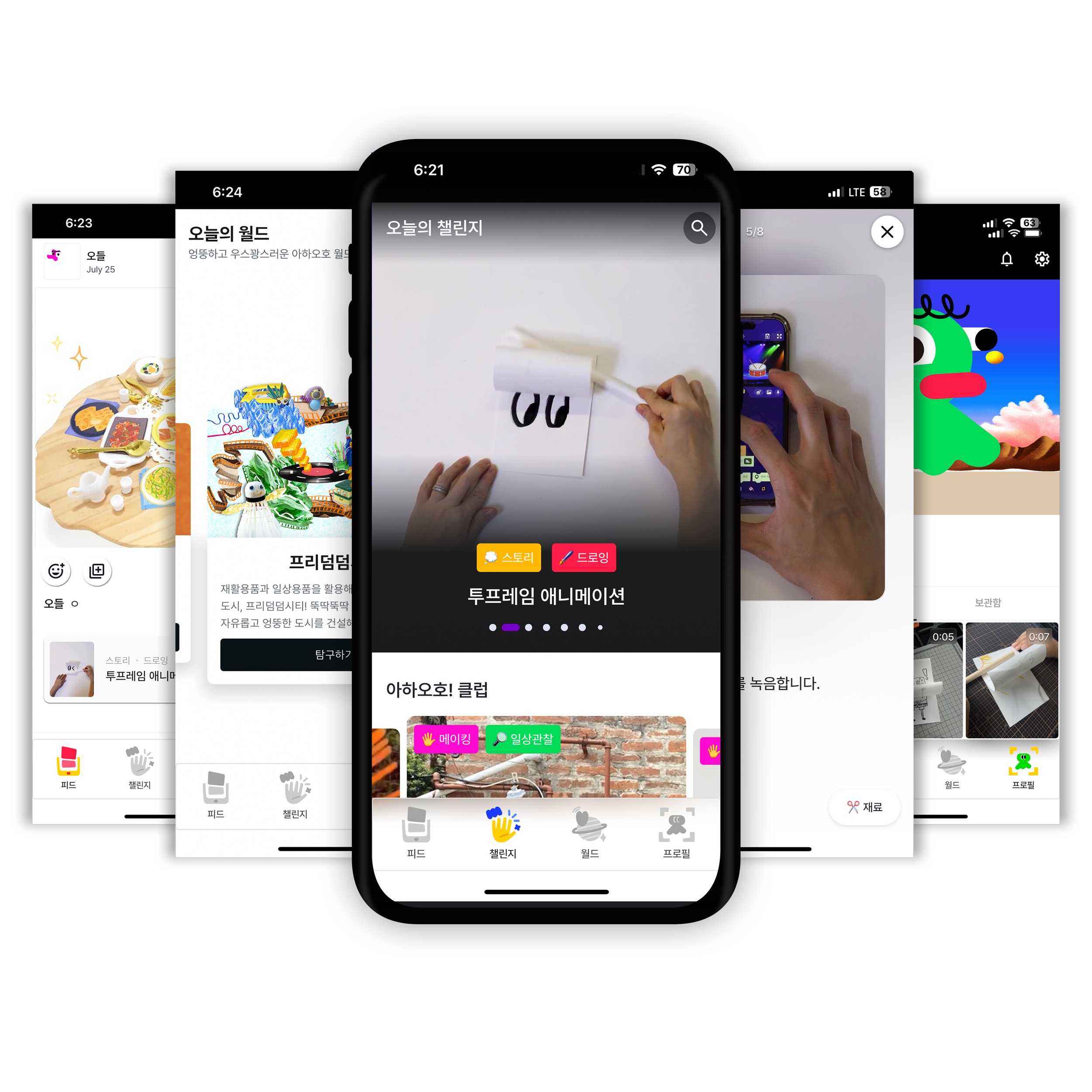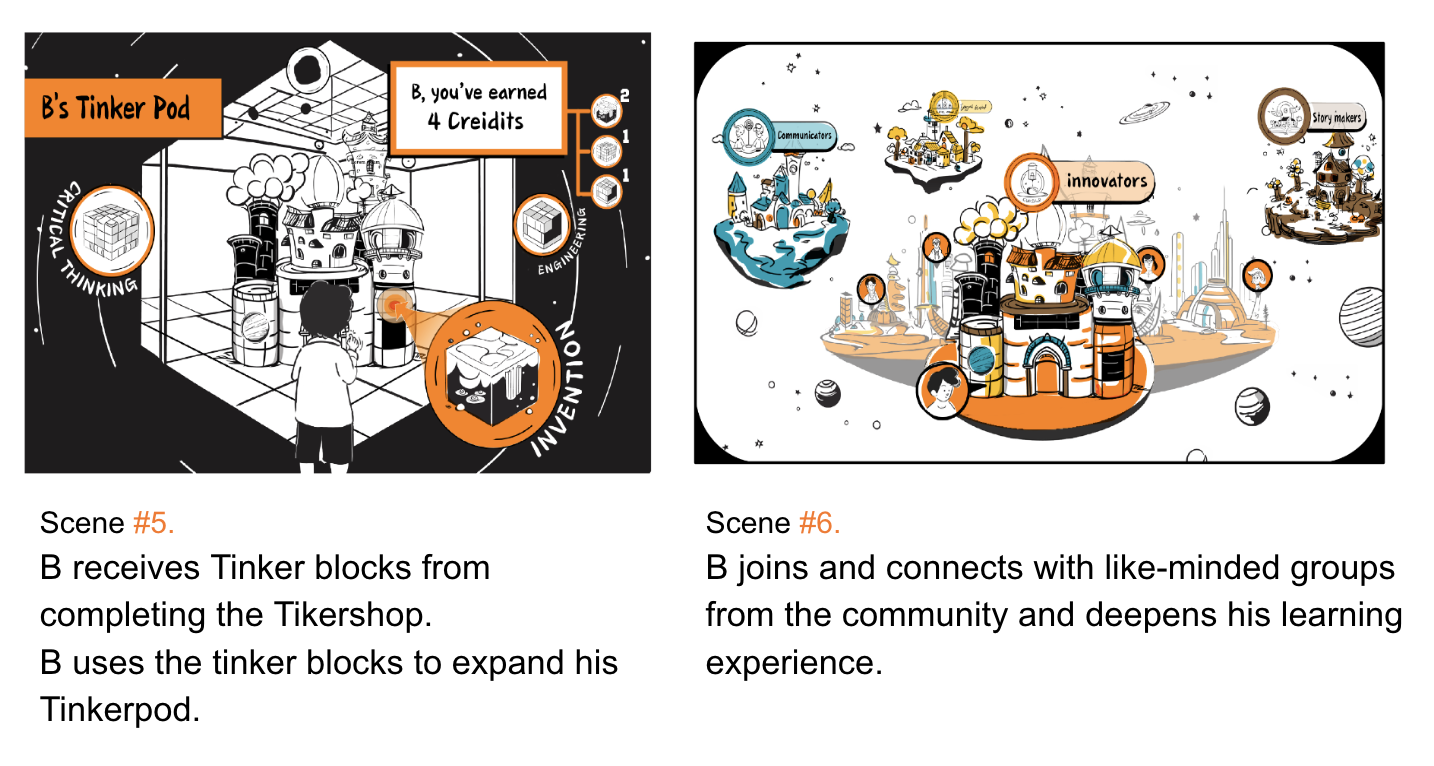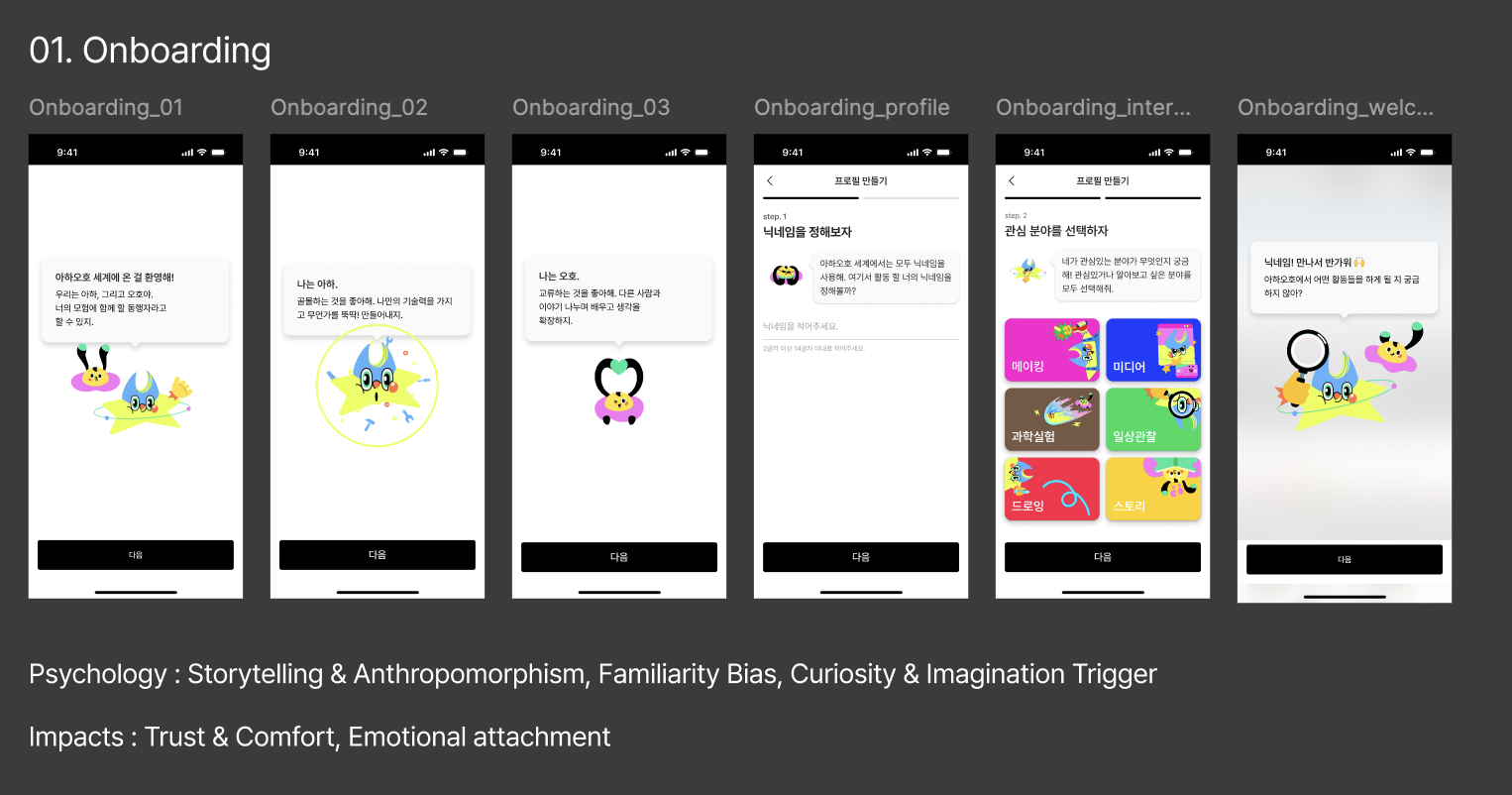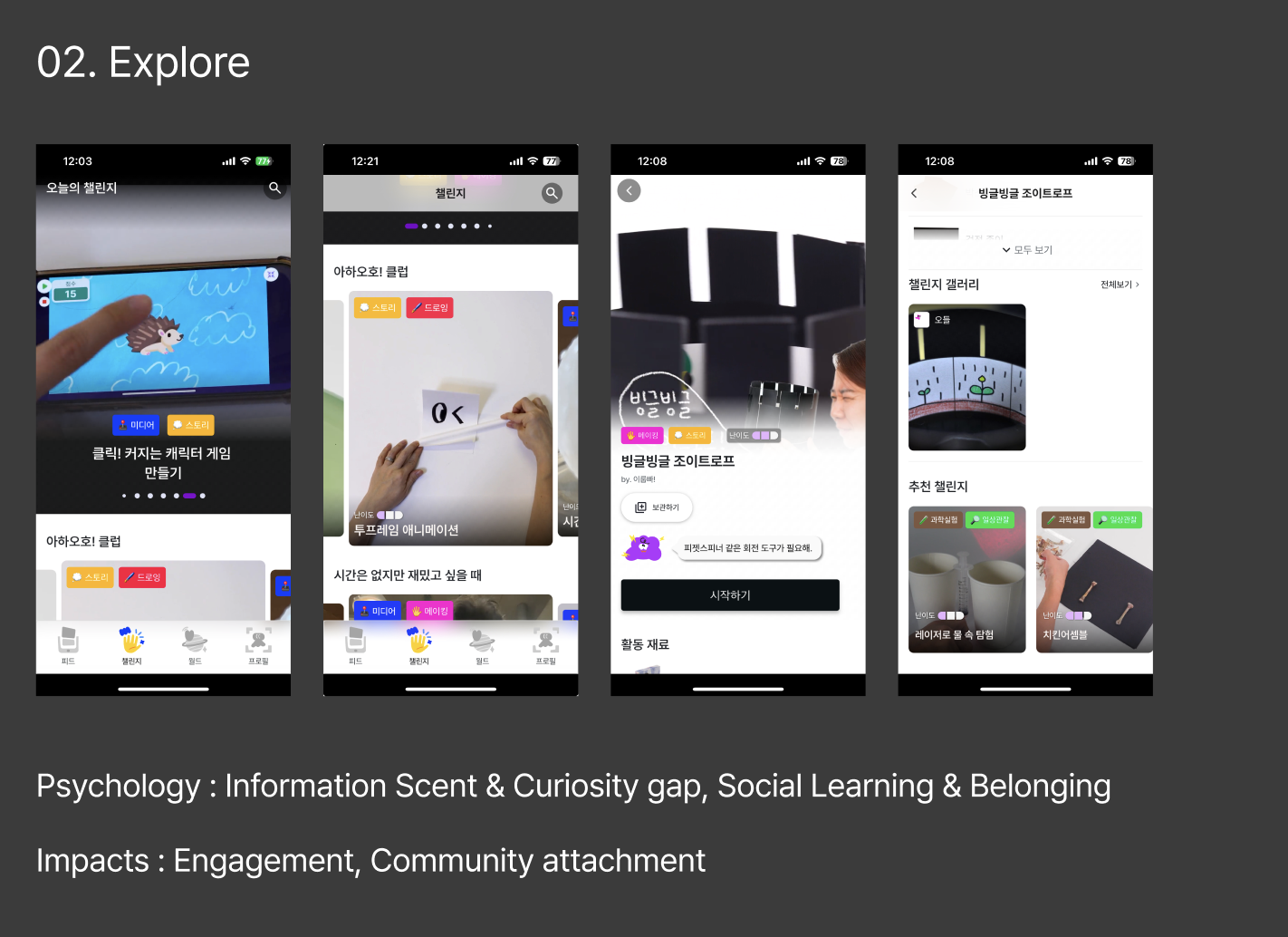AhhaOhho : Kids, Be Curious
Children’s Creative Learning App
✂️ Project
AhhaOhho is a creative learning app designed to help children rediscover their curiosity, express their ideas, and build confidence through self-directed creation.
Developed at FutureLab, the platform blends playful exploration, AI feedback, and gamified interactions to foster a safe, creativity-driven environment where kids can learn through curiosity, trial, and iteration at their own pace.
As the product design lead, I shaped the end-to-end user experience of AhhaOhho; from user research to gamified design strategies and prototyping that support tinkering, remixing, and peer-to-peer learning.
Company: Smilegate Futurelab Foundation
Deliverable: Mobile App (ios, android)
Role: Product Design Lead (Strategy, Research, IA, Prototyping, Interface)
Timeline: 2024 Q3 ~ ongoing
Platform: Mobile
✂️ Context & Challenge
Project Ahha Ohho addresses two main challenges :
1. The structural inequality in Korea’s education system
• Korea’s education system places overwhelming emphasis on standardized testing, leading to extreme disparities between students from different socioeconomic backgrounds. A recent survey shows that middle to high-income families spend 5x more on private education than low-income families, widening the gap in both opportunity and learning experience. Even when new learning formats like STEAM or maker programs are introduced, access still follows the same divide. These resources tend to reach kids from wealthier families, while those in low-income or rural areas are left out once again.
2. Children’s over-dependencies on smartphone and their graphic content consumption
• Mobile device ownership among children is higher than ever. Over 90% of 6th graders now own smartphones, and the government is pushing digital learning even further by distributing free devices. But how kids actually use these devices matters is a real problem.
Children from lower income households or rural region not only have higher smartphone ownership rates, but they also spend more time on their phones, often passively consuming short-form content or inappropriately graphic materials. These devices hold incredible creative potential, but without guidance, they often become tools for distraction rather than expression.
✂️ Generative Research & Persona Segmentation
✏️ Research through observational studies and facilitator interviews
✎ Objective
Understand traits of different educational environments and their digital maturity (devices, network, digital tools/technology provided, etc..)
Identify use cases and Persona segmentation for AhhaOhho
Assess needs and pain points from different user types
✏️ User Persona
✂️ Storyboard (Early Concept incorporating metaverse idea)
✂️ Product Definition
✏️ Product Objective
AhhaOhho fosters a creative environment for kids to engage with technology; not just to consume, but to explore, create, and share. By turning smartphones into tools for curiosity and self-expression, AhhaOhho focuses on making creative learning more accessible and giving kids agency to engage with technology as creators / problem-solvers
✏️ Product Identity
A creative-learning community app designed to help children rediscover their curiosity, express their ideas, and build confidence through making and sharing
✏️ Core Service Value
Explore through curiosity
Tangible, hands-on experiences
Iteration through peer feedback & social engagement
✂️ Design Approach
✏️ Building a consensus : “what does a creative environment mean to team AhhaOhho”
4 Pillars of AhhaOhho :
Inspiring Encounters • Creative Expression • Playful Engagement • Equitable Opportunities
These principle(pillars) shape AhhaOhho’s content, space, and culture: open‑ended making, mutual learning, safe failure, and delightful iteration
✏️ Primary UX Loop : Spiral Process of learning / tinkering
Curiosity(Browse) → Attempt(Make) → Record/Share → Feedback → Iterate
✏️ Facilitation Strategy : Interactive Emotional Scaffolding
Personalized content curation
Tailored questions
Chunk Instruction
Individualized AI feedback
✏️ Gamification Strategy (derived from Octalysis framework)
✎ Narrative & Role Assignment
Users join a mission-driven world with characters and streak-based onboarding rewards that boost early engagement
✎ Achievement Visualization
Dashboard displays badges, levels, and quest progress to help users track their growth and feel accomplishment
✎ Creative Empowerment
Missions allow free expression, remixing, and profile decoration. AI-guided prompts scaffold hesitant users
✎ Peer Interaction
Social feedback (e.g., emoji reactions, peer feed) builds relatedness and encourages iteration
✎ Content Timing
Limited-time quests and level-based content unlocks add momentum without pressure
✎ Surprise & Delight
Random rewards and visual storytelling spark curiosity and sustained exploration
✂️ Key Design Decisions & Implementation
✏️ Wireframe & Lo-fi prototypes (for early testing)
✏️ UI Design
1. Onboarding – Entry & Identity
• Goal : Lower entry barrier, strong initial immersion, early identity setup → foundation for long-term retention
2. Challenge – Exploration & Choice
• Goal : Increased activity discovery, higher participation through interest-based selection, formation of exploration loop
3. Project Sharing – Expression & Reflection
• Goal : Sustained content creation, deeper learning through reflection, accumulation of achievement, repeated engagement via recommended challenges
4. World Exploration – Narrative & Problem Solving
• Goal : Deeper immersion, meaningful motivation through contextualized challenges, higher re-engagement, more memorable experiences
5. Profile – Ownership & Personalization
• Goal : Stronger attachment to the platform, long-term content preservation, enhanced self-expression through avatar customization → higher revisit motivation
6. Social Interaction – Feedback & Recognition
• Goal : Strengthened community bonding, increased comments and reactions, habitual participation through social feedback
✏️ Implementation
✏️ Testing & Iterations
After numerous testing and interviews with children and facilitators, we’ve learned to iterate on the following:
Need age‑appropriate text for activity prompts and system modal
Need wider level of activities & example projects for different age / environment groups
Navigation & mental model felt a little confusing in places
Gesture interaction affordance needed to be more clear for children who are not familiar with a mobile device
Rewards & profile decoration triggered some motivatation, but gamification features need to be enhanced
Need Level‑up & curation for “what’s next.”
Text feedback feature is scary to have but it can work as one of the strongest source of motivation
✏️ Lesson Learned
The workshops and user tests showcased some encouraging moments where AhhOhho sparked curiosity and agency in kid participants. However, it also revealed key gaps and limitation when operating as a standalone service.
To ensure consistent engagement, we learned that:
A clear sense of purpose (missions, feedback, progression) is critical for maintaining motivation
First-time users wanted more intuitive onboarding to avoid feeling lost and get immersed into Ahha Ohho universe
Facilitators require tools not just for inspiration, but also ease of facilitation in educational group settings
✏️ What’s next?
To evolve AhhaOhho into a sustainable and scalable service, we’re focusing on:
Gamified structure with missions, story-driven characters, and rewarding progression
Interactive tutorials and visual guides to enhance usability from the first tap
Personalized content curation with AI-generated facilitation prompts based on interest and level
A membership system and community tools for facilitators to manage learners and share best practices
These improvements aim to turn AhhaOhho into not just a creative tool, but a living, growing platform that supports both self-directed learners and educational environments.


















